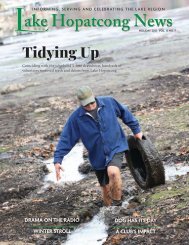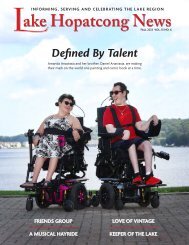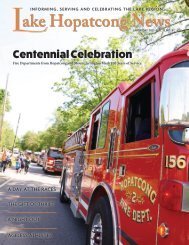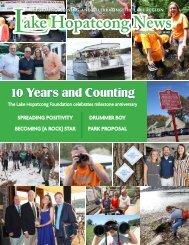Spring Issue
Create successful ePaper yourself
Turn your PDF publications into a flip-book with our unique Google optimized e-Paper software.
Lake
Closure in
2019 Spurs
Grants,
Changes
Story by MICHAEL DAIGLE
Photo by KAREN FUCITO
Sometimes it takes a shock to create action.
That seems to be the case following last
year’s lake-closing hazardous algal bloom (HAB)
that shut down activity on Lake Hopatcong
and 69 other New Jersey lakes starting in early
summer. Lake Hopatcong was declared clear
of the HAB, caused by aggressive growth of
cyanobacteria, in January.
Exposure to cyanobacteria can result in health
impacts, the state Department of Environmental
Protection said in its announcements, closing
lake after lake.
What the Lake Hopatcong HAB exposed
in very stark terms is what environmentalists,
scientists and lake organizations had been saying
for years: that overdevelopment and lax off-lake
management of potentially polluting runoff had
damaged the lake.
“The lake is sick,” Hopatcong Mayor Michael
Francis said in March.
In response to the HABs, New Jersey released
$2.5 million in local grants in March that would
support programs focused on specific causes
of lake pollution: runoff, weed growth, high
phosphorus concentrations and lack of oxygen in
specific areas of the lakes.
DEP Commissioner Catherine R. McCabe
said at the time of the grant announcement
that the department was seeking to expedite the
funding to meet the schedule required by local
municipal and county budgeting actions.
These grants are included in a $13.5 million
program announced in November by Gov. Phil
Murphy geared toward sparking action to head
off another year of what Francis last year called,
“The summer of green water.”
In February, Assemblywoman BettyLou
DeCroce of Roxbury separately filed legislation
that called for a statewide fund to battle lake
pollution, including annually $500,000 for the
Lake Hopatcong Commission and $53,000
for the Greenwood Lake Commission. The
money will come from the state’s watershed
A lone boater out on Lake Hopatcong taking advantage of a sunny day in April.
management fund, raised through the state’s
corporate business tax. The bill, which was sent
to the Assembly Environment and Solid Waste
Committee and is still pending, would provide
grants to local governments to fund sewer or
stormwater infrastructure projects that reduce
nonpoint source pollution of the state’s lakes
and reservoirs, and help prevent harmful algal
blooms.
The bill would also provide funds to support
local government efforts to purchase land for
recreation and conservation purposes to help
reduce the impact of runoff on the state lakes
and reservoirs.
IMPROVING COMMUNICATION
In addition to the funding, the DEP is
revamping its HAB communication program,
said spokeswoman Caryn Shinske.
Lack of clarity on the occurrence and scope of
the HABs created confusion, many local officials
said last year.
Shinske said that in November, the existing
DEP HABs website was updated to include
a new map of reported HABs by waterbodies
at www.nj.gov/dep/hab. Information was also
added to the website about what homeowners
and municipal officials can do to assist in
the prevention or treatment of HABs (septic
maintenance, for example), what can be done to
manage HABs in drinking water supplies, as well
as links to ongoing HAB-related research and
collaboration efforts.
She said the department is also working on
launching an interactive mapping tool that
will provide HAB data and photos for specific
waterbodies and increase alert methods to
include additional public notice options, such as
listserv and text alert messages.
As the HAB expanded last year, Francis called
for faster action to fight the condition. He called
for experimental programs such as adding weedeating
carp to a section of the lake, and for an
aeration program to stir the turbid lake waters
and add oxygen.
While the carp program did not get state
support in the recent grant announcement by the
DEP, Hopatcong will receive $145,680 to install
a pilot aeration system in Crescent Cove.
In that same grant program, the Lake
Hopatcong Commission received $500,000 to
support numerous cleanup efforts around the
lake.
This grant application was supported with
contributions and in-kind services from the Lake
Hopatcong Foundation, both Morris and Sussex
counties and the four lake towns, bringing the
value of the state grant to $833,000, said Jessica
Murphy, foundation president and executive
director.
SEWER PROJECTS
Separately, Hopatcong will proceed with the
installation of sewer service to 35 homes along
Hudson Avenue, a long-sought project, Francis
said. The borough will also install a water line at
the same time, he said, to provide public water
service to homes that two years ago saw their
private wells fail.
The sewer projects are vital to improving the
quality of the lake’s water, Francis said, and an
improvement over septic systems, especially in
Hopatcong’s rocky lakeside terrain.
“This a big help,” he said. The DEP said 52
percent of the 2019 HAB was related to nutrients
from septic system runoff.
The new sewer line will run 2,300 feet and
cost an estimated $600,000, said John Ruschke,
borough engineer. But, he added, approval of a
state grant for the project could reduce the cost
10
LAKE HOPATCONG NEWS Spring 2020

















